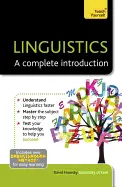
Linguistics: A Complete Introduction - by David Hornsby
ISBN: 1444180320Date read: 2024-08-10
How strongly I recommend it: 5/10
(See my list of 430+ books, for more.)
Go to the Amazon page for details and reviews.
Lessons in linguistics for beginning students of the subject.
my notes
To avoid problems of dialects rather than languages, linguists talk of language varieties.
All languages with alphabetic writing systems present inconsistencies.
Pronunciation changes too rapidly for spelling to keep up.
Writing systems are often a better guide to the way languages used to sound.
The 8.25 Geneva to Paris express which leaves each day is ‘the same train’ in spite of the fact that its coaches, driver and locomotive are probably not the same each day: we would continue to call it the ‘8.25 Geneva to Paris’ train even if it left a few minutes late.
The inherent qualities of the train itself do not matter.
The worlds in which different societies live are distinct worlds, not merely the same world with different labels attached.
Language is something that defines experience for us.
The larynx or ‘voice box’, situated at the top of the windpipe, are the vocal cords, the gap between which is called the glottis.
When these cords are kept close enough together and made to vibrate as air passes through the glottis, the sound produced is voiced.
Where there is no vibration the sound is voiceless.
All vowels in English are voiced; consonants may be voiceless or voiced.
Speech sounds may also be oral or nasal, depending on whether or not the velum (or soft palate) is lowered to allow air to pass through the nose as well as the mouth.
English has only oral vowels, but nasal and oral consonants.
French, Portuguese and Polish have nasal vowels as well as nasal consonants.
Consonants are produced by full or partial obstruction of the airstream, while vowels are produced by positioning the tongue in different configurations which do not impede the flow of air.
You’ll feel your larynx vibrating for [b] and [d], but not for [p] and [t], because the former are voiced sounds, while [p] and [t] are voiceless.
These sounds are therefore bilabial.
By contrast, for [t] and [d] the tongue touches the back of the teeth and the alveolar ridge to produce a dental-alveolar sound, while contact between tongue and soft palate produces the velar sounds [k] and [g].
Other English consonants are labio-dental (bringing bottom lip and top teeth together), palatal (the tongue meets the hard palate), alveolar-palatal (closure is made at the point where hard palate and alveolar ridge meet) or glottal (involving full or partial closure of the glottis).
The consonants [t, d, k, g] are produced by releasing pressure behind the tongue.
Sounds like these are called plosives.
Plosives are literally small explosions in the vocal tract, and therefore cannot be extended.
They are very different, therefore, from the [f] and [v] sounds in five, which you can extend for as long as you have enough breath.
For these sounds, the airstream passes through the articulators to produce audible friction, hence the name fricatives.
As was the case for the plosives, the fricatives come in voiceless/voiced pairs:
[f] and [v] are voiceless and voiced labio-dental fricatives
L at the end of cool and the beginning of leap are quite different, but speakers think of them as ‘the same’ sound.
The nonsense words of Lewis Carroll’s famous poem Jabberwocky work because all these words could exist in English: they just happen not to. They represent what linguists call accidental gaps.
Only a minority of present and past languages have a writing system.
Blackbird, for example, is one word rather than two because, unlike black bird, it carries only one main stress.
From other languages: robot (Czech); shampoo (Hindi).
Infixes, inserted within words, but there are some informal expletive or emphatic uses, e.g. a-whole-nother story, abso-bloody-lutely.